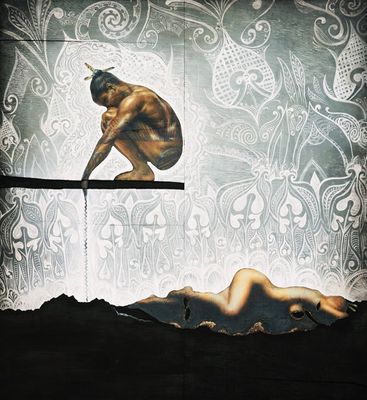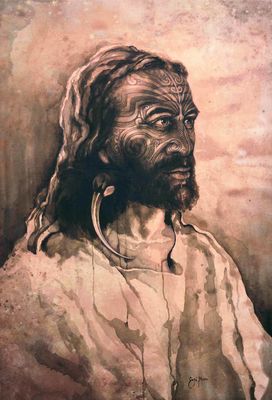
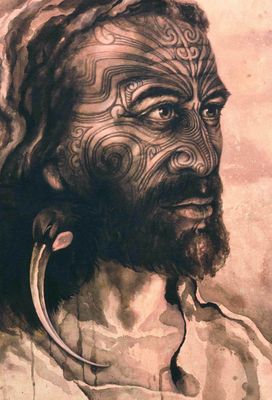
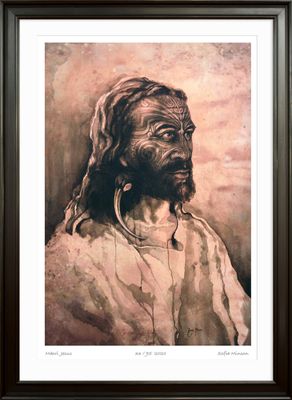
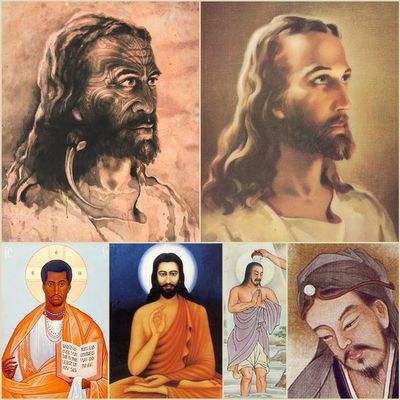
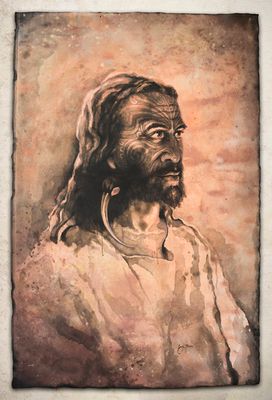
Māori Jesus
$950.00
Explore the story of the artwork >>
Print sizes and editions
- Regular museum archival paper print - 771 x 525mm
(limited to 95) - Large museum archival paper print - 1099 x 748mm
(limited to 75)
Your unique limited edition fine art print
- Sofia Minson creates your exclusive signed print
- We ship for $25 in NZ and from $50 internationally
- Your artwork arrives rolled, ready to be framed - do you need help? Request framing guidance
Original painting SOLD, acrylic on canvas, 1480 x 970mm, 2014.
The story of Māori Jesus
"Māori Jesus" is Sofia Minson's depiction of the Messiah as tangata whenua (indigenous Māori) with full-face moko (traditional tattoo).
Minson has painted 'Maori Jesus' with an extinct native huia bird tucked into his neck, in the vein of C.F. Goldie and Gottfried Lindauer's 19th century portraits of Maori.
Rebirth
Easter is traditionally a time of rebirth, fertility, the resurrection of Christ and Springtime. Minson celebrates a revival in the the art of Māori portrait painting, which has arguably been in limbo since the likes of Goldie and Lindauer.
While Minson is inspired by their works, she says her Māori portraits "are far from Goldie's recordings of a vanishing race" and are intended to fill an important niche for her generation.
Nowadays we find that it is not so easy to define who or what is Māori. As a Māori artist of mixed heritage (Ngati Porou, Swedish, English and Irish) she uses traditional Western figurative painting to show the living, evolving and diverse culture of Māori in the 21st century.
Questioning tradition
Minson says her personal goal with this portrait "is to sense the fluidity and exchange of faith, wairua (spirit), culture, art and religion between people through the ages. Her representation of Christ as ethnically Māori may provoke questions about cultural appropriation by religion, a widely-talked-about example being early Christianity, which developed in an era of the Roman Empire, adopting European Pagan symbols and rituals in order to replace diverse beliefs and practices with the new religion. It may also call into question the line between 'sacred' and 'profane' both in terms of Christianity and Māori tradition.
Take for example the practice of Ta Moko Kanohi (facial tattooing), which with its mark carries deep ancestral ties. Is it profane for Jesus to wear a moko in this picture, or is it sacred? Is it profane to see moko drawn on the faces of Māori cultural performers, or does kapa haka and other creative pursuits have the sacred role of carrying the culture and ties to our ancestors forward into a new generation?
Interest in James K. Baxter
When creating this work, Minson was also interested in James K. Baxter (1926 - 1972) and his poem "The Maori Jesus." Baxter was one of the first Pakeha to respect the mana (honour) of Maori, who he insisted should be treated as the 'elder brother' in terms of spirituality and wisdom. A section of the poem goes as follows:
"The Maori Jesus said, 'Man,
From now on the sun will shine.'
He did no miracles;
He played the guitar sitting on the ground.
The first day he was arrested
For having no lawful means of support.
The second day he was beaten up by the cops
For telling a dee his house was not in order.
The third day he was charged with being a Maori
And given a month in Mt Crawford.
The fourth day he was sent to Porirua
For telling a screw the sun would stop rising.
The fifth day lasted seven years
While he worked in the Asylum laundry
Never out of the steam.
The sixth day he told the head doctor, 'I am the Light in the Void; I am who I am.'
The seventh day he was lobotomised; The brain of God was cut in half."
- James K. Baxter
Blending the old with the new
With Easter's focus on rebirth, let's consider that for a culture to survive and for its people to flourish, it must constantly re-make itself and become a blend of old and new. Māori culture has been doing this since the Māori renaissance of the 1970s and the revival of te reo (the Māori language). For a religion such as Christianity to flourish it naturally does the same thing, it blends old doctrine with the new culture and face of the people who are converting to the religion.
The Face of Jesus
In a December 2013 Huffington Post article by Jesse Washington entitled "The Race Of Jesus Is Unknown Yet Powerful", the matter of the racial portrayal of Jesus throughout history is discussed:
For two thousand years, he has been worshipped and adored. Multitudes look to him each day. And yet nobody really knows the face of Jesus. That has not stopped humanity's imagination, or its yearning to draw Jesus as close as possible.
Why should we even care what Jesus looked like? If his message is God and love, isn't his race irrelevant? Some say God wanted it that way, since there are no references to Jesus' earthly appearance in the Bible.
Jesus in Colour
Jesus can be safely categorized as a Jew, born about 2,000 years ago in the Middle East in what is now Palestinian territory. Therefore, many scholars believe that Jesus must have looked "Arab," with brownish skin.
"Today, in our categories, we would probably think of him as a person of color," said Doug Jacobsen, a professor of church history and theology at Messiah College.
If this is so obvious, though, why does a Google image search for "Jesus" reveal countless pictures of a European man with straight hair, fair skin and, often, blue eyes? Why is that the prevalent image in America, from stained glass windows to movies to children's books?
The many depictions of Jesus
The first pictures of Jesus appeared several hundred years after his death, said Edward Blum, co-author of "The Color of Christ: The Son of God and the Saga of Race in America." Some depicted him in animal form, as a lion or a lamb. Blum said that from about 700 to 1500 A.D., various Jesus images proliferated throughout Europe, the Middle East and northern Africa -- including hosts of black Jesus pictures.
Sofia Minson Paintings | New Zealand Artwork

